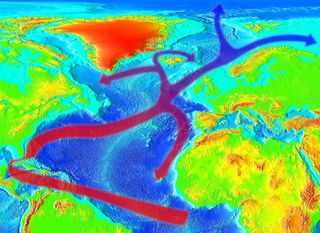The Gulf Stream is slowing to a 'tipping point' and could disappear
The current could slow down to a point of no return, altering the climate on both sides of the Atlantic.

The Gulf Stream — one of Earth's major climate-regulating ocean currents — is moving slower than it has in thousands of years, a new study suggests. Human-induced climate change is largely to blame.
This "unprecedented" slowdown could impact weather patterns and sea levels on both sides of the Atlantic, the researchers found. And it only looks poised to worsen over the coming decades if climate change continues unabated. Indeed, if global warming persists at its current pace, the Gulf Stream could pass a critical "tipping point" by the year 2100, lead study author Levke Caesar, a climatologist at Maynooth University in Ireland, said, potentially causing the current to grind to a halt, regardless of the climate.
This disruption could unleash rising sea levels along the coasts of North America and northwestern Europe, and usher in more extreme weather such as heat waves and cyclones.
"If the Gulf Stream crosses its tipping point, it will continue to weaken even if we have managed to stop global warming," Caesar told Live Science. "Afterwards, it will slow down by a lot, coming close to a complete shutdown of the circulation."
Related: 10 Steamy signs that climate change is speeding up
The great conveyor belt
The Gulf Stream (also known as the Atlantic Meridional Overturning Circulation, or AMOC) is essentially a "giant conveyor belt" along the East coast of the United States, study co-author Stefan Rahmstorf, a researcher at the Potsdam Institute for Climate Impact Research (PIK) in Germany, said in a statement.
The current begins near the Florida Peninsula, carrying warm surface water north toward Newfoundland before meandering east across the Atlantic. By the time it reaches the North Atlantic, that warm surface water becomes cooler, saltier and denser, sinking into the deep sea before being driven south again, where the cycle repeats. According to Rahmstorf, the current moves more than 5.2 billion gallons (20 million cubic meters) of water per second, or "almost 100 times the Amazon [River] flow."
Sign up for the Live Science daily newsletter now
Get the world’s most fascinating discoveries delivered straight to your inbox.

This wet conveyor belt has myriad climate impacts on both sides of the Atlantic, keeping temperatures in Florida and the U.K. mild, influencing the path and strength of cyclones and helping to regulate sea levels. Since direct measurements began in 2004, however, scientists have detected a troubling pattern: AMOC currents are getting slower and weaker.
To better contextualize this slowdown in their new study — published Feb. 25 in the journal Nature Geoscience — the researchers attempted to extend the history of the AMOC's flow by nearly 2,000 years. Because no direct measurements of the flow are available before the last two decades, the team turned to proxy data: information from environmental archives, such as tree rings and ice cores, that can help put the AMOC in a long-term perspective.
The team used 11 different proxies — including temperature records, Atlantic silt data, underwater sediment cores and deep-sea coral population records — to create a comprehensive picture of how warm the AMOC was and how fast it was moving over the past 1,600 years.
"We looked for example at the size of the grains in ocean sediment cores, as a faster current can transport larger grains," Caesar said. "We also looked at the species compositions of corals, because different types of corals prefer different water temperatures, and the Gulf Stream system influences water temperatures in the North Atlantic."
Together, these proxies told a unified story about the current's sudden decline, beginning with a small slowdown in about 1850, at the end of the Little Ice Age (a period of global cooling that spanned from roughly 1300 to 1850). A second, more dramatic slowdown began in the mid-20th century; since then, currents have weakened by an additional 15%, the team found.
"We found consistent evidence that the system over the last decades has been weaker than any time before in the last 1,600 years," Caesar said.
Past the tipping point
This slowdown is a predictable effect of climate change, the researchers wrote.
Global warming increases annual rainfall and accelerates the melting of ice sheets, including the Greenland Ice Sheet in the North Atlantic. Both of these factors dump ever greater amounts of freshwater into the ocean, reducing the density and salinity of the surface water at the northern end of the Gulf Stream conveyor belt. According to the researchers, this freshwater inhibits how quickly the water can sink and begin its journey back south, weakening the overall flow of the AMOC.
The team concluded that, at the current rate of climate change, the Gulf Stream's flow could weaken by an additional 45% by the year 2100, plunging the current close to a critical tipping point. If the flow continues to weaken (or collapse entirely), the effects could be severe.
"Several studies have shown that a slowdown of the [AMOC] exacerbates sea-level rise on the US coast for cities like New York and Boston," Caesar said. Other studies have linked severe heat waves and storm patterns in northern Europe and the eastern United States to the weakened current.
The precise impacts could be "even more severe," Caesar said, though scientists won't know for sure until we cross that bridge. Hopefully, by limiting global warming as much as possible in the coming decades, we'll never have to find out.
Originally published on Live Science.

Brandon is the space/physics editor at Live Science. His writing has appeared in The Washington Post, Reader's Digest, CBS.com, the Richard Dawkins Foundation website and other outlets. He holds a bachelor's degree in creative writing from the University of Arizona, with minors in journalism and media arts. He enjoys writing most about space, geoscience and the mysteries of the universe.
Most Popular



